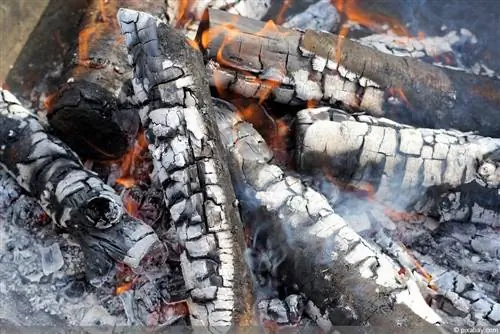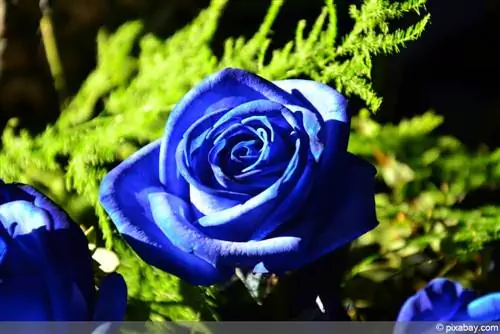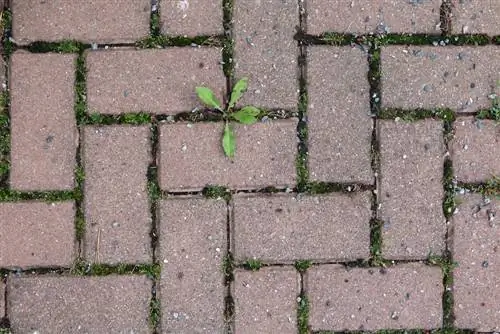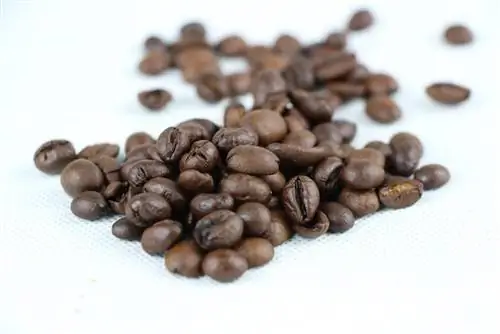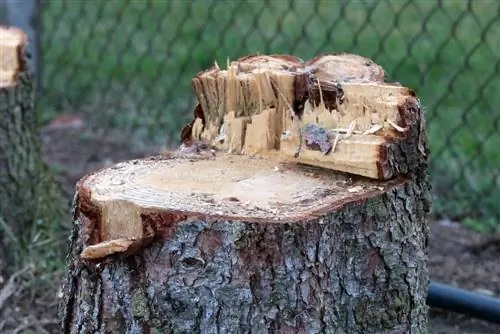- Author admin [email protected].
- Public 2023-12-17 03:39.
- Last modified 2025-01-24 12:45.
With its bright red flower heads, the Burning Love ornamental perennial plays an impressive role in the summer garden. The shapely flowers with their colorful signaling effect are enthroned on tightly upright stems up to 100 cm high. Even Johann Friedrich von Goethe was amazed at the sight of blooming Lychnis chalcedonica, who praised the scarlet carnation as the most beautiful garden ornament. How good that the carnation plant is so uncomplicated and can be cultivated without any extensive gardening knowledge. The proof is provided by the following care instructions, which explain all the important details to you.
Location
If the scarlet carnation finds a location that suits its sunny disposition, it feels in good hands. The more sun rays stroke the umbrella-shaped flowers, the more lush the colors unfold. Although the stems are robust and strong, a location protected from the wind effectively prevents a disheveled appearance. The most important location conditions at a glance:
- Full sun to sunny location,
- Warm, protected from wind and rain
- Fresh soil, not too dry and well drained
- Loose soil, humus and nutrient-rich
Regardless of her hunger for sun, Burning Love prefers common garden soil rather than the poor soil of the rock garden.
Tip:
In the pot, a burning love is clearly visible when it can extend its roots into high-quality potted plant soil. This is structurally stable, contains little or no peat and retains its loose consistency all year round.
Pouring
Don't let the magnificent perennial come under drought stress, the water balance is in balance. Water a scarlet carnation whenever the surface of the soil has dried out. To determine this, press a finger into the substrate. If the first 1-2 cm feel dry, water is needed. In midsummer this can be the case every day, as the flower evaporates a lot of liquid in a sunny location. Water directly onto the root slice in the early morning or late evening. When exposed to direct sunlight, water droplets turn into small burning glasses that can damage the foliage and flowers.
Fertilize
In order to develop the opulent flowers and leaves, a burning love should be supplied with sufficient nutrients. A mineral-organic starter fertilizer gets the perennial plant going in May. From June to August, fertilize with compost and horn shavings every two weeks. Cultivated in a bucket, a Lychnis chalcedonica happily accepts liquid fertilizer for flowering plants every 14 days.
Tip:
Please note that fertilizers are not applied to dry soil. If in doubt, first pour a M altese cross with clear water and then administer the preparation.
Cutting
Experienced hobby gardeners use secateurs to have a lasting effect on the duration of the flowering period. We have put together all the occasions when a Burning Love is cut for you below:
- Clean out wilted flower heads regularly
- Optionally cut back after the first flowering period in July to encourage further flowering
- In the late morning, cut stems with newly opened buds as vase decorations
It is up to your individual decision as to when you cut the withered re-flowering. A prompt pruning down to the basal leaf rosettes saves the perennial from the strenuous growth of the capsule fruits with the seeds. However, if self-sowing is desired in the garden, leave the stems until the first frost or late winter.
Wintering
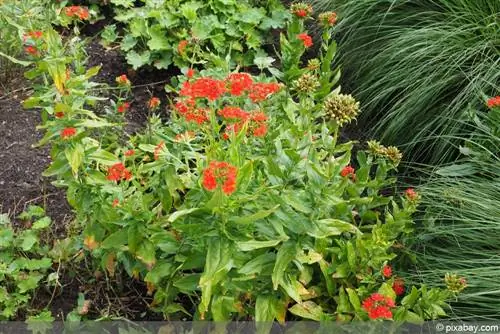
She's tough, because a burning love can endure temperatures down to -34 degrees Celsius without complaint. As a result, the perennial survives the winter he althy and undamaged without any special precautions. This at least applies to M altese crosses in the bed. If the plant thrives in the pot, it should be protected. Due to the exposed location of the root ball, there is a risk that it will freeze and cannot withstand the stresses of frost and thaw. Therefore, wrap pots and flower boxes in bubble wrap in good time and place the containers on wood or Styrofoam. The substrate receives a thick layer of leaves, straw, brushwood or sawdust.
Tip:
The wintergreen foliage also evaporates moisture in winter. Therefore, pour a Burning Love when there is a clear frost when there is no water-giving snow cover in the bitter cold.
Propagate
For breeding Lychnis chalcedonica, choose the method that suits you from the following two methods. Both of them are uncomplicated to execute.
Division
The best time for propagation by division is in autumn, when the soil is deeply warmed. If you miss this date, start breeding in the spring as soon as the ground has completely thawed. How to do it right:
- Loosen the root ball well all around with the digging fork
- Use the spade to lift the perennial out of the ground and place it on a firm surface
- Using a sharp knife or spade, divide the root ball into 2 halves or 4 quarters
- When dividing in autumn, leave the leaves that have not yet grown on the plant
As long as a ball piece has at least 2 eyes, it has the potential to become a new Burning Love. At the new location, plant the segments 30 cm apart in the thoroughly raked, compost-enriched soil and water. It is important to note that the previous planting depth is retained.
Sowing
In order to fill the peaceful winter time with useful gardening activity, you can sow scarlet carnations on the warm windowsill from January to March. To make it easy to handle the tiny red-brown seeds, they are mixed with fine bird sand. It's a good thing that we're dealing with normal germinators here, because sowing is so easy:
- Fill small pots or a seed tray with peat sand, pricking soil or commercially available seed soil
- Sprinkle the seed-sand mixture thinly, sieve with substrate 0.5-1 cm thick and press down
- Ideally, you water the seeds from below by placing the container in water for a few minutes
In the indoor greenhouse or on the windowsill, germination takes between 1 and 3 weeks at 20 degrees Celsius. During this time, keep the substrate constantly moist. If at least two pairs of leaves have developed on a seedling, it is transplanted into an individual pot. By mid-May, your pupils will have transformed into vital young plants and will be planted out in the bed or pot.
Tip:
If you put a transparent hood over the seed container, germination will progress quickly in the warm, humid microclimate created underneath. If the cotyledons break through the seed coat, the cover has done its job and is removed.
Diseases and pests
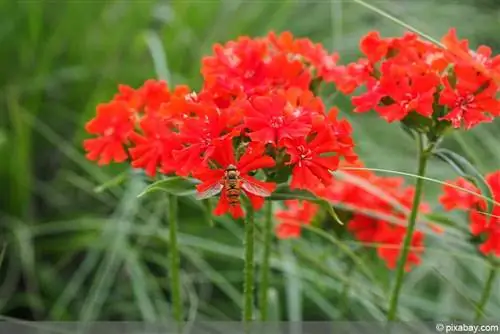
Its robust constitution does not protect the Lychnis chalcedonica from infestation with diseases and pests. The main ones to be mentioned here are the fungal infection mildew and the sap-sucking aphids. In both cases there is no need to use chemicals to rid the scarlet carnation of the plague because there are two effective home remedies available. A mix of 900 ml water and 100 ml fresh milk, which is sprayed on every 2-3 days, works against the mealy-gray fungal coating. The classic soft soap solution kills the aphids. To do this, add 15 ml each of pure soft soap and spirit to 1000 ml of water and apply the solution to the top and bottom sides of the leaves.
Beautiful varieties
The noble flower species presents us with beautiful varieties that are not limited to the red signal color. We have put together recommended Lychnis chalcedonica for you here:
Burning Love ‘Plena’
A premium variety with scarlet red, double flowers that leaves nothing to be desired. The silvery, shimmering leaves remain green in winter and decorate the otherwise bare garden.
- Growth height 80-100 cm
- Flowering period from May to July with re-blooming in September
Burning Love 'Hoarfrost'
The simple, white double flowers contrast wonderfully with the light red colors of their counterparts. An indispensable variety for the creative cottage garden and naturally cultivated beds.
- Growth height 90 cm
- Flowering in June and July and September
Burning Love ‘Carnea’
An impressive variety with countless pink starry flowers that come together to form umbrella-shaped flower heads. This Lychnis chalcedonica is also ideal as a cut flower for the vase.
- Growth height 110-130 cm
- Flowering period from June to August
Conclusion
With an unmistakable presence, Burning Love stretches towards the sun with its bright red flowers. In order for the ornamental perennial to stage this summer blossom festival in your garden, a manageable amount of effort is required. In a sunny location, in fresh, moist and nutritious soil, the Lychnis chalcedonica is undemanding and frugal. Regular watering in dry conditions and fertilizing every two weeks from May to August prepares the summer beauty for a long flowering period. If you cut off the first flower tuft just above the basal rosette of leaves, the scarlet carnation will thank you for your efforts with pretty subsequent blooms. Thanks to its robust frost hardiness down to -30 degrees Celsius, no precautions need to be taken in the bed for the winter period. When it comes to propagation, the uncomplicated care instructions continue seamlessly, because by dividing the root ball you can grow vital offspring in no time.


